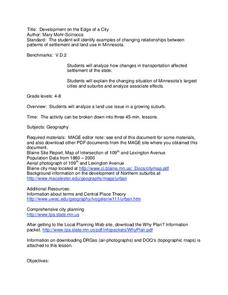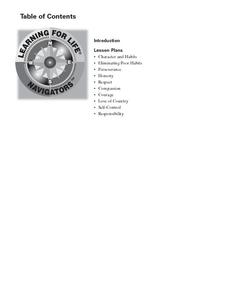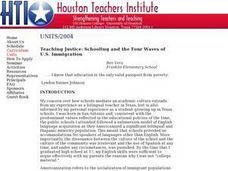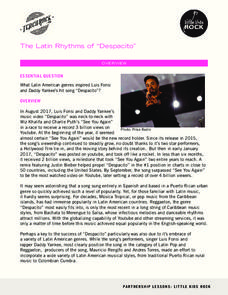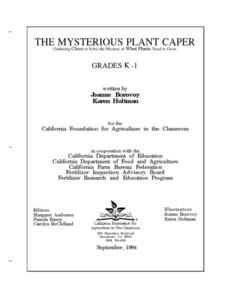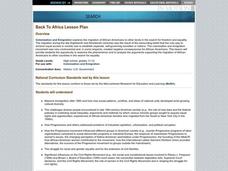Population Connection
Where Do We Grow from Here?
Did you know that the population is expected to grow to 11 billion by 2100? The resource serves final installment in a six-part series on the global population and its effects. Scholars interpret data from the United Nations about the...
Curated OER
National Symbol Patterns
Students practice their patterning skills using national symbols.
Curated OER
Flags
First graders investigate flags and their meaning. In this flag instructional activity, 1st graders explore the flags of states that grow rice. Students understand that flags have meaning and match flags to their states.
Curated OER
Development on the Edge of a City
Students explore and analyze examples of changing relationships between patterns of settlement and land use in the state of Minnesota. They view different avenues of transportation, cities, suburbs, city planners and suburbanization.
Learning for Life
Character and Habits
Part of growing up is differentiating between good and bad habits; developing the positive and eliminating the negative. This resource on life skills can be adapted to almost any age group. Class members participate in multiple...
Curated OER
Growing in Communities, Kids on the Grow
Students participate in an after school program that promotes concern for others, recognizing differences, accepting differences, leadership roles, mentoring, self-responsibility and personal safety. They explore the diversity of their...
Curated OER
The Celts
Look far back in history and you'll meet a people group called the Celts. Celts, as you'll soon find out, are a group of people who inhabited Britain 2000 years ago. Presented here, is simple information which describes a bit about...
Curated OER
Teaching Justice: Schooling and the Four Waves of U.S. Immigration
U.S. immigration is the focus of a unit on social justice. Over the course of a school year, young historians read a variety of texts to learn about four waves of immigration that have occurred over time in the U.S. An emphasis on...
Little Kids Rock
The Latin Rhythms of “Despacito”
When you hear the first few beats of "Despacito," the unrivaled Latin pop hit of 2017, you can't keep your feet from moving! A music analysis lesson plan examines the intoxicating hit by Luis Fonsi and Daddy Yankee and introduces the...
Curated OER
What's For Dinner?
Eighth graders discover how the location of restaurants affects the future location of different restaurants. Using a fictionous town, they map the locations of all current restaurants and analyze the data to determine what type of...
Curated OER
What Do I Want To Be When I Grow Up?
Students explore numerous types of careers. As a class, they list people they know and the types of jobs and services that are provided. Students discuss the responsibilities of having a job. Volunteer students explain what they wish...
Curated OER
Molly Pitcher -- "Out of Many, One"
Students research, brainstorm and analyze the events that lead up to the Revolutionary War. They critique a piece of artwork depicting a scene from the Revolutionary War. Each major battle is plotted on a map to show a visual...
Curated OER
The Climate Change Skeptic's Argument: Natural Solar Cycles or Human Activity?
Teachers explore patterns in sunspots and total solar irradiance to understand the counterpoint to the human effect of global warming. In this professional development tool, teachers work through a lesson on the sun's natural...
Curated OER
Canada and its Trading Partners
Students identify the relationship between Canada and its trading partners. They use two data sources, Canadian Statistics and E-STAT, on the Statistics Canada website to explore the growing importance of trade in general.
Curated OER
The Population Explosion: Causes and Consequences
Students use this lesson to focus on population growth and the threat of overpopulation. In groups, they analyze the world birth and death rates to determine the growth rate of the population. As a class, they discuss the causes and...
Curated OER
Poetry of Abraham Lincoln
Fourth graders analyze Abraham Lincoln's poems "The Bear Hunt" and "My Childhood's Home" for word choice and deeper inquiry into the vocabulary he uses to convey emotion. They identify rhyming words and patterns in these poems. ...
Curated OER
The Mysterious Plant Caper
Students investigate the basic parts of plant and that plants are living things which require water, air, light and nutrients for survival. They do this through a series of scientific experiements and multi-curricular hands-on activities.
Curated OER
Growing Pains of the Yearling
Fourth graders read The Yearling by Marjorie Kinnan Rawlings.
Curated OER
Does Conflict Shape Nations? The Middle East
Young scholars locate settlements and observe patterns in the size and distribution of cities using maps, graphics, and other information. They explain the processes that have caused cities to grow.
Curated OER
Sports Franchises: The Demographic Dimension
Students examine how U.S. population patterns have changed over time. Using the growth of major league baseball to illustrate these patterns, students create maps, examine regional migration patterns, and make predictions for the future.
Curated OER
Back To Africa
Pupils analyze the massive immigration after 1850 and how new social patterns, conflicts, and ideas of national unity developed amid growing cultural diversity, and how the Progressive movement influenced different groups in American...
Curated OER
Every Grain Counts
Students research a variety of facts about rice. They read books, access information on the Internet and use maps to determine major rice growing areas in the world and the patterns of distribution for this crop. Students create maps to...
Curated OER
Rock-a-bye Babies in a Wetland
Students review the way human babies grow and what type of care they need. Using the internet, they are introduced to five different wetland habitat animals and how their babies grow. They discover how they are born and what the...
Curated OER
Populations in the Path of Natural Hazards
Students read "Geographical Mobility: 1995-2000." They examine the maps in the handouts and compare them with maps from an atlas. In the second part of this lesson, students read "In Harm's Way." They receive three more handouts, one a...
Other popular searches
- Growing Patterns in Math
- Identifying Growing Patterns
- Growing Patterns Math
- Simple Growing Patterns
- Growing Patterns Activity
- Growing Patterns Worksheets
- Growing Patterns 100 Chart
- Growing Patterns That Double
- Growing Patterns en Espanol
- Growing Patterns in Nature
- Graphing Growing Patterns
- Growing Patterns and Rules



